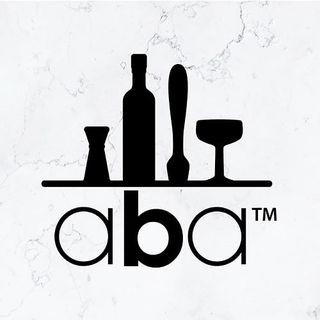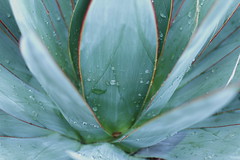
Mezcal & Tequila
Tequila is actually a type of Mezcal which is made in the Jalisco region of Mexico and is typically made from the Blue Agave plant. Since it is by far the most common type of Mezcal, we will spend most of our time in this section discussing Tequila. First, let’s quickly discuss how it’s made and some other spirits that are not considered Tequila. Then, we’ll spend the next two tabs discussing the two different ways to categorize Tequila: by the geography of where the Agave is grown, and by the amount of time that the spirit spends in oak.
How Mezcals are Made:
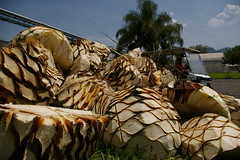
- The Agave plant, or Maquey are first grown to maturity and then chopped down to separate the leaves from the plant.
- What’s left when the leaves are removed is the heart of the plant, which resembles a fat pineapple and is called a Piña.
- The Piña is chopped down into small pieces and roasted to allow the starches to develop into sugars. The roasted pieces are crushed to extract the “sweet water” that is then fermented and distilled in the way we’ve discussed in the “Distillation” section.
- After it is distilled it may or may not be aged in oak – we will talk about that later and how it can impact the flavor profile of the spirit.
How is Mezcal different from Tequila?:
Mezcal is made from the Maguey plant (a type of Agave) and the process differs from Tequila most notably in the way the Piña is cooked. When making mezcal, the Piña is generally cooked in earthen ovens – basically a pit in the ground filled with hot coals, loaded with Piña and then covered with earth. The smoke is not able to escape from the coals and the resulting mash has a very smokey flavor. This smokey flavor is one of the defining characteristics of Mezcal you an find in the market today.
A Comment on Mixto Tequila:
“Mixto” tequilas are made with a minimum of 51% agave, with the rest typically coming from other sugars. They also may include other flavor and color additives. In my opinion there is no reason to buy Mixto tequila at all – there are so many 100% agave tequilas that are very reasonably priced, it just doesn’t make sense to risk your cocktail quality. Be sure when you buy your tequila that the bottle says “100% Agave.”
Highland vs. Lowland Tequila
Jalisco as a region can be divided into two “types” of geography. The highland and the lowland or valleys. Just like wine, the “terrior” of where the Agave plant is grown can definitely affect the final flavor of the tequila.

It’s important to note that the flavor differences between the Highland & Lowland tequilas are most distinguishable in the blanco or silver types. As the tequilas are aged in oak, the oak flavor will dominate and can cover any discernible difference in the tequila’s terroir. We’ll discuss how barrel aging affects the tequila’s flavor in the next tab.
The Highlands:
The highlands are, like it sounds like: at a higher elevation. As a result they see more rain and colder nights & winters. The highlands also have a red clay soil that’s generally not found in the lowlands.
Their taste profile tends to be:
- More fruit, citrus & pepper driven
- More delicate, with some floral qualities
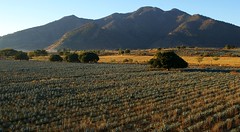
The Valleys / Lowlands:
In contrast to the highlands, the lowlands stay warmer at night and in the winter. The Agave plant’s mature size is about 30% smaller than a mature highlands’ Agave plant. Their flavor emphasis tends to be:
- Earthy, mineral driven. Some say they have a “wet clay” aroma
- More spiced, cinnamon flavor
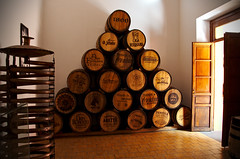
Barrel Aging Tequila
Some tequilas are aged in oak barrels, which can make a significant difference to the taste. It’s pretty easy to tell how much oak a tequila has seen – the spirit will be labelled with the appropriate designation, as described below:
Type |
Aging |
Characteristics |
Used in Cocktails? |
| Blanco or Silver | 0 to 2 Months | It is most possible to taste the differences between highland & lowland tequilas in Blanco and Silver tequilas. The flavor profile of these tequilas tend to be brighter, with a natural sweetness. Blanco or Silver tequilas are completely clear. | Yes. These two are the most commonly used types of tequilas in cocktails. |
| Reposado | 2-12 Months | Many of the subtle differences between high & lowland terroir are covered up by the honey and vanilla flavors from the barrel aging. The spirit becomes a light gold color and the taste is a balanced mix of the agave and barrel flavors. | |
| Añejo | 1-3 Years | The long time spent in oak has a significant affect on the flavor of this type of tequila. It becomes darker in color and more rich with the barrel-contributed vanilla and baking spice flavors. Añejo tequilas have a much richer mouth feel – starting to be similar to bourbon or cognac. | Rarely. Añejo tequilas can be used in cocktails when the creator is looking to add a richer mouth feel, vanilla quality and hint of cooked agave. Keep in mind this is a more expensive tequila, and that’s primarily why it is rarely used. |
| Extra Añejo | 3+ Years | Extra Añejo is very expensive and delicious! It is like a drinkable dessert with flavors of butterscotch and caramel. | No. Extra Añejo tequilas are very high quality and very expensive. It would be wasteful to use them in cocktails as their richness and quality would not be discernible in a mixed drink. |
In general, the longer the tequila spends in oak, the more the fresh agave flavor is replaced by the influence of barrel contact, imparting more vanilla, honey and baking spice flavors.


